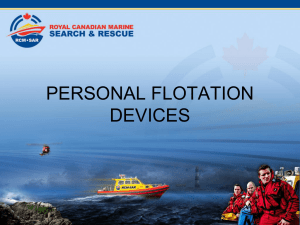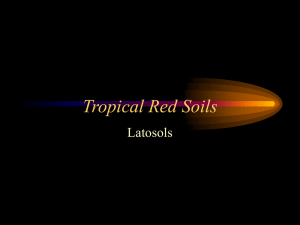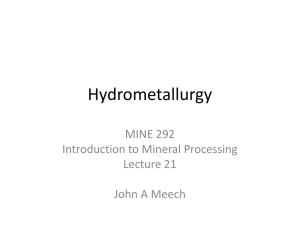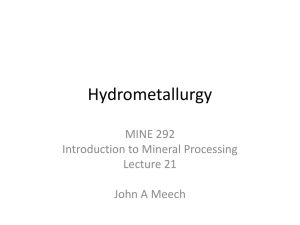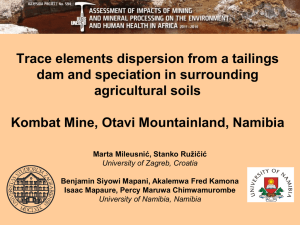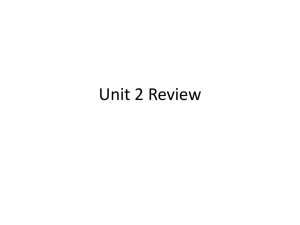Click to add title - CERM3 - University of British Columbia
advertisement
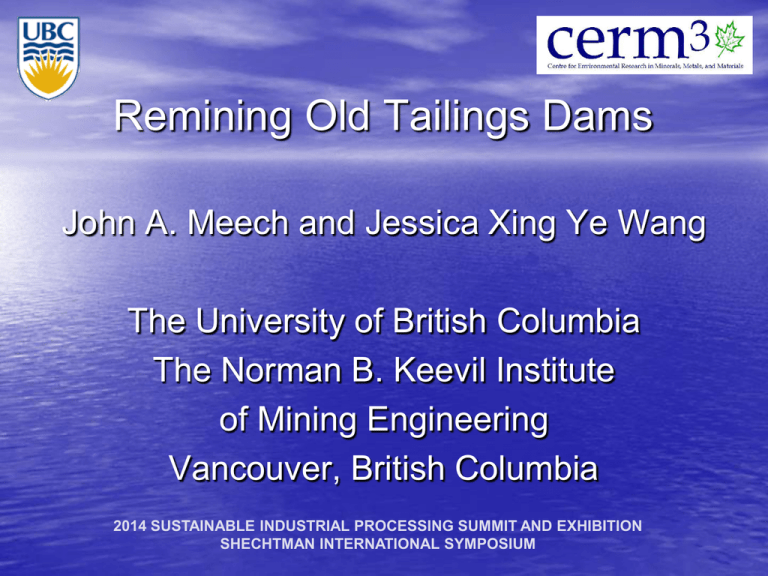
Remining Old Tailings Dams John A. Meech and Jessica Xing Ye Wang The University of British Columbia The Norman B. Keevil Institute of Mining Engineering Vancouver, British Columbia 2014 SUSTAINABLE INDUSTRIAL PROCESSING SUMMIT AND EXHIBITION SHECHTMAN INTERNATIONAL SYMPOSIUM Outline Background Tailings Retreatment Tailings Retreatment Model – Design and Economic Module – Disposal and Reclamation Module – Risk Assessment Module – Decision-Making Module Validation and Verification Conclusions and Recommendations 2014 SUSTAINABLE INDUSTRIAL PROCESSING SUMMIT AND EXHIBITION SHECHTMAN INTERNATIONAL SYMPOSIUM Issues with Old Tailings Dams Stability (slopes, erosion, chemicals) Aquatic Emissions (acid, metals) Atmospheric Emissions (toxic gases, mercury) Dust releases Dam failures High-grades of values Revegetation and reclamation 2014 SUSTAINABLE INDUSTRIAL PROCESSING SUMMIT AND EXHIBITION SHECHTMAN INTERNATIONAL SYMPOSIUM Environmental & Social Concerns • Physical Stability • Failure Dust Issues Chemical Stability Acid Rock Drainage Metal Pollution Dam Failure - 1994 Merriespruit Mine, South Africa Sources: http://www.tailings.info/merriespruit.htm • Social Concerns: Poor reputation of mining Close monitoring by public/aboriginals/ NGOs Political pressure (local/global) Regulation requirements Dust - Colomac Mine Yellowknife, NWT ARD Britannia Mine, BC http://www.aadnc-aandc.gc.ca/eng/1100100026732/1100100026841 Tailings Retreatment Processes Mining Processing Disposal Reclamation • Hydraulic Mining • Mechanical Excavation • Grinding • Heap leaching • Tank leaching • Flotation • Flotation concentrate/tailings leaching • New surface impoundment • Underground/open pit backfill • Sub-marine/lake • Water treatment plant • Passive treatment • Covers (water/dry covers) • Revegetation Simplified Flowchart of Retreatment Method Tailings Retreatment Investment opportunity Revenue from metal extraction Offset of rehabilitation costs Dam Failure prevention Elimination of pollution remediation costs Long-term liability reduction 2014 SUSTAINABLE INDUSTRIAL PROCESSING SUMMIT AND EXHIBITION SHECHTMAN INTERNATIONAL SYMPOSIUM Tailings Retreatment Model A Model to Assist Decision-making on Retreatment of Copper Tailings Dams Model addresses two issues: • Economic benefits • Improvements in long-term liability “Should you reprocess the tailings?” How does it work? • Input via a set of questionnaires • Data processed by model • Generates a report Framework of the Tailings Retreatment Model Tailings Retreatment Model An Excel spreadsheet model including: Mathematical calculations Fuzzy Logic Rule-based System 2014 SUSTAINABLE INDUSTRIAL PROCESSING SUMMIT AND EXHIBITION SHECHTMAN INTERNATIONAL SYMPOSIUM Tailings Retreatment Model Fuzzy Sets Rule Base Fuzzy Associative Memories Site Characteristics Submarine Disposal Poor Mod Good Low Low Low Low Mod Low Mod Mod High Low Mod High Environmental Sustainability Weighted-Inference Method Defuzzification Method a DoB W * DoB conc i i i 1 z m i 1 [ DoB( zi ) * Sup( zi )] m i 1 DoB( zi ) DoB = Degree of Belief (0-100) and Sup = Supremum Design and Economic Module Mass Balance Economic Criteria Capital and Operating Cost NPV & DCFROR Tonnage Rate Optimization A Project NPV @ 5% Copper Recovery Project Saving on Current Remediation Cost B Base Case PV @5% and Avoidance of Future Failure Costs C Total NPV @5% Sum of A & B Flowsheet Selection D Project NPV @10% Not Used Sensitivity Analysis Procedure for Flowsheet Selection and Economic Analysis E DCFROR Not Used Flowsheet Alternatives - Excavation or Monitor Mining - Grinding coarse or bulk 1. Flotation (bulk) 2. Regrinding (coarse) + Flotation (bulk) 3. Flotation (bulk) + heap leaching flotation tailings 4. Flotation (bulk) + tank leaching of concentrate 5. Flotation (bulk) + heap leaching of concentrate pile 6. Heap leaching (bulk) 7. Heap leaching (coarse) 8. Agglomeration/heap leaching (bulk) 9. Tank leaching (bulk) 10. Tank leaching + Flotation of leach residue 11. Regrinding (coarse) + Tank leaching (bulk) Complete Retreatment Flowsheet – over 1,000 combos Flowsheet Alternatives - Excavation or Monitor Mining - Grinding coarse or bulk 1. Flotation (bulk) 2. Regrinding (coarse) + Flotation (bulk) 3. Flotation (bulk) + heap leaching flotation tailings 4. Flotation (bulk) + tank leaching of concentrate 5. Flotation (bulk) + heap leaching of concentrate pile 6. Heap leaching (bulk) 7. Heap leaching (coarse) 8. Agglomeration/heap leaching (bulk) 9. Tank leaching (bulk) 10. Tank leaching + Flotation of leach residue 11. Regrinding (coarse) + Tank leaching (bulk) Complete Retreatment Flowsheet – over 1,000 combos Flowsheet Alternatives - Excavation or Monitor Mining - Grinding coarse or bulk 1. Flotation (bulk) 2. Regrinding (coarse) + Flotation (bulk) 3. Flotation (bulk) + heap leaching flotation tailings 4. Flotation (bulk) + tank leaching of concentrate 5. Flotation (bulk) + heap leaching of concentrate pile 6. Heap leaching (bulk) 7. Heap leaching (coarse) 8. Agglomeration/heap leaching (bulk) 9. Tank leaching (bulk) 10. Tank leaching + Flotation of leach residue 11. Regrinding (coarse) + Tank leaching (bulk) Complete Retreatment Flowsheet – over 1,000 combos Flowsheet Alternatives - Excavation or Monitor Mining - Grinding coarse or bulk 1. Flotation (bulk) 2. Regrinding (coarse) + Flotation (bulk) 3. Flotation (bulk) + heap leaching flotation tailings 4. Flotation (bulk) + tank leaching of concentrate 5. Flotation (bulk) + heap leaching of concentrate pile 6. Heap leaching (bulk) 7. Heap leaching (coarse) 8. Agglomeration/heap leaching (bulk) 9. Tank leaching (bulk) 10. Tank leaching + Flotation of leach residue 11. Regrinding (coarse) + Tank leaching (bulk) Complete Retreatment Flowsheet – over 1,000 combos Flowsheet Alternatives - Excavation or Monitor Mining - Grinding coarse or bulk 1. Flotation (bulk) 2. Regrinding (coarse) + Flotation (bulk) 3. Flotation (bulk) + heap leaching flotation tailings 4. Flotation (bulk) + tank leaching of concentrate 5. Flotation (bulk) + heap leaching of concentrate pile 6. Heap leaching (bulk) 7. Heap leaching (coarse) 8. Agglomeration/heap leaching (bulk) 9. Tank leaching (bulk) 10. Tank leaching + Flotation of leach residue 11. Regrinding (coarse) + Tank leaching (bulk) Complete Retreatment Flowsheet – over 1,000 combos Design and Economic Module Base Case Economic Analysis - Future Failure Cost 5 year failure probability = 5% Year of certain failure = 50 Weibull Cumulative Failure Probability vs. Time Disposal & Reclamation Module INPUTS Alternatives Definition (Scoping) Site Characteristics Tailings Characteristics Option 2 Option1 ….... Option n Local Climate Topography Land Disturbance Cost Environment & Stability Alternatives Evaluation (Scoring and Ranking) Preferred Disposal and Reclamation Methods Social and Political Acceptance Weight Factors Tailings Disposal and Reclamation Selection Module Disposal & Reclamation Module Risk Assessment Module Identify Potential Failure Modes and Mechanisms FAM Map for Risk Characteristics What can happen? Hazard Assessment Exposure Assessment How likely is it to happen? What are the consequences if it happens? Consequence Assessment Risk Characterization What is the risk of each failure mode? Risk Assessment Module Hierarchy of the Risk Assessment Module Decision-Making Module • Decision-Making Criteria: • Economic Performance Economic Issues = NPV @5% • Environmental Performance = DoB • Current Risk = DoB Technical Issues SocialEnviron mental Issues Three Pillars of Decision-Making about Tailings Retreatment Validation and Verification Four hypothetical cases Element Scale Grade, %Cu Dust Problem Dam Stability Effluent pH Acid Generation Potential Remediation Project Impact on Community MINE A Large 0.12 No Poor >7 MINE B Large 0.18 No Medium 3-4.5 MINE C Medium 0.12 Yes Poor 5-6 MINE D Small 0.18 Yes OK 5-6 High Medium Low Low WTP None None None High High Medium Low Validation and Verification Model Results Environmental Risk Factor Performance (DoB) (DoB) Cases Economic Benefit (NPV@5%) Retreatment Recommendation (DoB) Mine A $135.5 M 80 56 95 Mine B Mine C Mine D $177.3 M $ -13.1 M $ 10.8 M 67 66 18 Expected Results 88 85 84 95 24 43 Cases Economic Benefit Current Environmental and Social Risk Environmental Performance Retreatment Recommendation Mine A Mine B Mine C Mine D Medium Very-Good Very-Low Low High Medium to High Medium to High Low Medium High High High High High Medium Medium Validation and Verification Project Economic Sensitivity Analysis Percent Change in Input Variable to Yield an NPV @5% = 0.0 Cu Head Grade or Price Capital or Operating Costs MINE A -25% +40% MINE B -28% >+50%* MINE C +10% -15% MINE D -8% +20% * Actually gives an NPV of $100M 2014 SUSTAINABLE INDUSTRIAL PROCESSING SUMMIT AND EXHIBITION SHECHTMAN INTERNATIONAL SYMPOSIUM Recommendations Conclusions Conclusions • The model is able to: • Conceptually design a tailings retreatment process • Evaluate economic and environmental benefits • Assist in multi-criteria decision-making Further modules or rules for: • Detailed mining method selection • Unit processing operations selection • Additional reclamation technologies User interface to enter or modify internal parameters Practical "real" cases of copper tailings to be tested 2014 SUSTAINABLE INDUSTRIAL PROCESSING SUMMIT AND EXHIBITION SHECHTMAN INTERNATIONAL SYMPOSIUM THANK YOU FOR LISTENING! Questions? 2014 SUSTAINABLE INDUSTRIAL PROCESSING SUMMIT AND EXHIBITION SHECHTMAN INTERNATIONAL SYMPOSIUM
